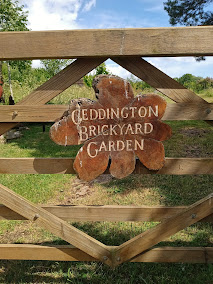 |
A nice local walk today under blues skies and sunshine. We are in the historic village of Geddington.
Getting here was good fun in the car as we had to go through a 'Ford'. Someone was taking the opportunity to wash their vehicle in it too.
The biggest claim to fame though is that it is home to a Queen Eleanor Cross. The monument dates from 1294, when the crosses were raised as a memorial by Edward I to his late wife Eleanor of Castile(1241–1290). Originally there were 12 memorial monuments on the route that marked the resting places of the funeral procession. These days there are only three left that resemble their original state.(Northampton and Waltham Cross as well).
 |
We set off past the church of St Mary Magdalene. The Churchyard has two Commonwealth War Graves. Both of them relate to The Royal Air Force. One being a Navigator, the other an Aircraftman. We are walking towards Geddington Chase. We pass a little oasis of calm in 'The Geddington Brickyard Garden'. A community project working to transform a former derelict site at the end of Wood Street (known locally as The Brickyard) into a place of natural beauty. The idea for the GBG project began in January 2014 when Boughton Estate, the landowners, offered support for initial proposals. Since then, with hard work from many volunteers, huge progress has been made in developing the area. GBG is a long-term project and the wildlife-friendly green space will continually evolve over time as long as funding and volunteering continues.
 |
It certainly looks a great place to come and get involved with planting and growing, or just relaxing.
 |
Geddington Chase is a surviving fragment of the medieval Royal Forest of Rockingham. Part of it in the North West Corner is designated as biological site of Special Scientific Interest (SSSI). There is actually no public access as it is private land. Centuries ago the Forest would have been crucial to the survival of the village providing timber and
other resources (legal & otherwise).
It is said that Mary Queen of Scots when imprisoned in Derbyshire was robbed, with the two men responsible caught on the Chase, the money and jewellery were never recovered and may still be buried there.
No luck in finding any treasure today though sadly. The views are superb though, and we spotted a couple of Hares charging through the meadows.
 |
Read more at Gardening Know How: What Is Flaxseed – Tips On Growing Your Own Flaxseed Plants https://www.gardeningknowhow.com/ornamental/flowers/flax/growing-flaxseed-plants.htm
A few weeks ago the field would have been a carpet of blue flowers. The flowers have gone now, and the crop won't be long off harvesting. Rich in fibre and Omega 3. The seed is considered to be something of a 'wonder food'. It can help with conditions such as; Diabetes, Liver disease, Heart Disease, Strokes and even Depression. The seeds will be collected up ground and pressed to release their natural oil. This can then have a variety of uses from cooking to skin care.
Read more at Gardening Know How: What Is Flaxseed – Tips On Growing Your Own Flaxseed Plants https://www.gardeningknowhow.com/ornamental/flowers/flax/growing-flaxseed-plants.htm
Read more at Gardening Know How: What Is Flaxseed – Tips On Growing Your Own Flaxseed Plants https://www.gardeningknowhow.com/ornamental/flowers/flax/growing-flaxseed-plants.htm
 |
 |
Not quite so enjoyable was the attention shown to us by a large heard of cows (and a large Bull). It was made worse by us having a dog with us, and them having calves. Quite cleverly they split up and actually started circling us....Whenever I'm in these situations I always get the stat about the number of human deaths caused by cows come into my head... Which really isn't at all helpful. Not at all conducive to a peaceful, calming stroll in the country. It is with no little relief that we make it to a gateway. The fun and games isn't over yet though as no way could I get the gate to close securely. At any moment they could burst through.. Eventually it fastened to my immense relief.
Back in Geddington a much need pint was enjoyed at the Star Inn. 'Fools Nook' 3.8% brewed at nearby Barnwell went down very well. A lovely walk (apart from the cows) and came in at just over 7.75 miles.


























































